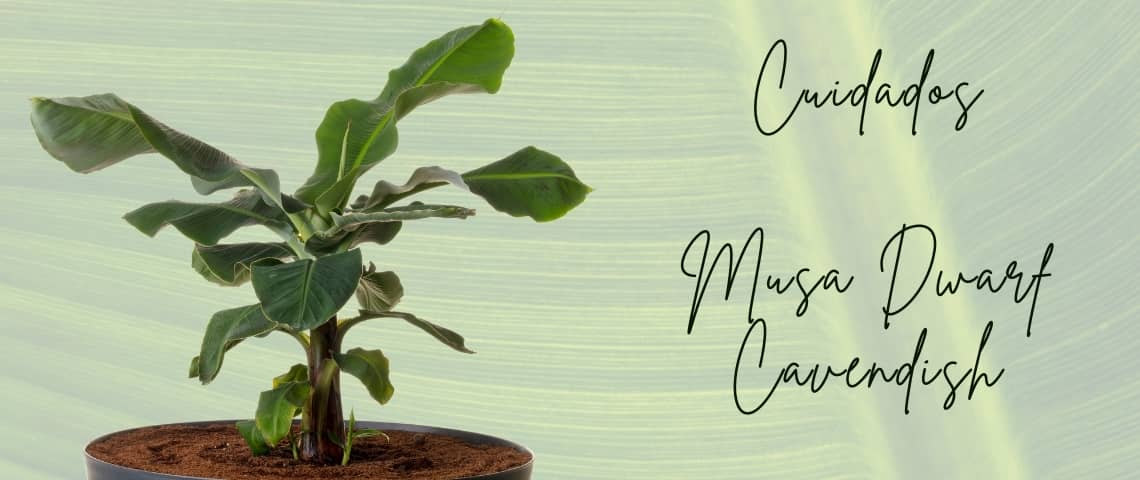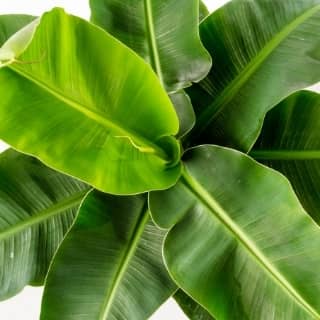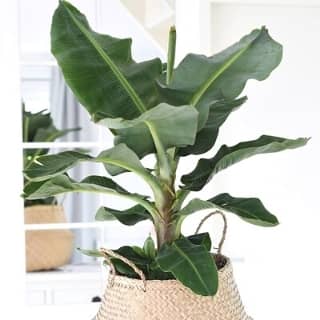-
All care tips for the Musa Dwarf Cavendish

The musa dwarf cavendish is also known as the banana plant. It originated in Southeast Asia and Australia, but today this plant grows in many tropical and subtropical places. There are about 400 species, but in the middle room you will almost always find the musa tropicana or the musa acuminata dwarf cavendish. These plants are relatively small in size, which is why they are also called dwarf plantain. However, compared to the average houseplant, the dwarf plantain is not small at all. With proper care, this species can reach a height of 2 metres.
In terms of care, the plantain plant requires some attention. It is important that the potting soil never dries out and that the plant is placed in a bright spot. Read on for all the care tips.
information about the musa
Did you know that... the muse has been around for about 10,000 years? It is even believed that this plant produced the first fruit in the world. The plant was first brought to Europe in 1834 by the chaplain of Alton Towers. In the UK in a stately home now better known as a theme park. The plants were gifted to William Cavendish, the 6th Duke of Devonshire, who had them grown in his greenhouses and then named them after himself, so why not give them their own name?
To create your urban jungle at home you should have a banana tree at home, on your balcony or in your garden. Yes, it is a versatile plant. It can be kept indoors as well as outdoors.
Will you get to eat fruit from your own muse? Yes, it is possible, but the conditions will have to be exceptional for the plant. So you have to be quite patient because they don't come out overnight.
In general, the dwarf cavendish muse is not toxic to humans and animals. So you can safely put it in the house.

its characteristics
The musa dwarf cavendish banana tree is named after its short, 2.5 to 3 metres high stem. The young leaves are purple or red, but turn green as they grow and produce large flowers.
The banana that emerges from the flowers is the same size as a normal cavendish banana with a length of six to 10 inches. The skin starts out green and turns yellow when the banana is ripe, and the inner flesh is white.
an easy indoor and outdoor plant
Finding a plant that is easy to care for doesn't have to be a challenge. The banana muse is a fairly easy plant to maintain, both indoors and outdoors. It's nice to have such a green and tropical plant that creates so much happiness and peace at home, on your balcony or in your garden.
tips to take care of your muse
Before buying a banana tree, you should consider the following ideal growing conditions. It can be kept outdoors and indoors. If you choose to have it in your garden, in addition to a planter, it can also be planted in the ground.
location
The ideal location for a dwarf cavendish muse is a place that receives direct sunlight, such as a room with a sunny window or in the backyard away from shade. A banyan tree can survive in partial sun, but that can slow the growth of an otherwise easy-to-grow plant.
during summer
During summer, the sun can shine very brightly, so brightly that the leaves of the muse will burn. Especially when the plant has just come from the nursery, where it has grown under filtered light. In this case, let your banana plant get used to direct sunlight gradually, i.e. introduce it little by little to the bright Spanish sun.
the soil or substrate
Musa dwarf cavendish banana trees like well-drained clay soil, which is a mixture of sand, silt and a little clay. They prefer a pH between 5.5 and 6.5, which means they love an acidic substrate.
temperature
There is really no upper temperature limit in the home that is detrimental. However, heat sources or too much sunlight should be avoided. Windows (glass) can raise the temperature. When the banana tree is outdoors, the plant will start to suffer damage if it is placed in an area below 8-9ºC. In summer, be careful with the hottest days and avoid the plant being in the sun for too long.
environmental humidity
The banana tree in general and the leaves love humidity, after all, it is a plant that is used to the humidity of the rainforest. Therefore, try spraying water on a leaf-by-leaf basis. Do this once or twice a week with a plant sprayer. If you have it outside, be careful with the sun, do this in the afternoon before sunset.
watering

The banana tree is 80% water and therefore needs a lot of water. Make sure the soil is constantly moist by regularly giving it small amounts of water. This will also prevent a layer of water forming at the bottom of the pot. If the Muse receives too little water, its leaves will start to drop.
Given its tropical origin, the banana plant needs high humidity. You can maintain this by regularly spraying the plant with water. For this, it is best to use lime-free water or rainwater. Another thing the plant will thank you for is to put it outside during a hot summer shower. Rainwater contains a lot of nutrients.
water shortage
If you water your muse too little, the leaves will start to droop, if that continues, they will dry out quickly. Always anticipate this by making sure the substrate dries out a little. Check twice or three times a week in spring and summer. This way you can see if the plant is craving another splash of water. Stick your finger a centimetre into the soil to check the soil moisture; if it is dry, water it. Never let the soil dry out completely between waterings.
over-watering
Too much water on the other hand can cause yellow spots on the leaves and leaf drop. If you have a saucer under the pot, check if the plant is not in a puddle of water and remove the excess water directly. If the soil is really too wet, it is important to replace the substrate so that the roots do not remain in this condition for too long.
fertiliser
Banana trees grow quite fast and therefore need a lot of nutrition. So if you want your muse to grow a lot and happily, give it some nutrition in spring and during the summer every fortnight or 30 days when watering with a liquid fertilizer for green plants or for tropical fruit trees.
transplanting
As the Musa grows fast, it is advisable to repot it into a larger pot every two years (if you want it to keep growing of course). It is preferable to do this in spring or early summer and always choose a pot that is at least 20% larger than the old one.
propagation
Take two parts of the same Muse plant and that will come small seedlings, they are the offspring of the Dwarf Cavendish Muse. With great care you could separate them from the mother plant. This is not very easy, but not impossible. Dig a little bit next to the seedling you want as a cutting and remove it without pulling it out. You can put this plant in a pot with the same substrate as the mother plant.
possible pests and diseases
In general, Dwarf cavendish banana trees are quite tolerant of high temperatures and are native to warmer parts of the world, such as Southeast Asia and Central and South America. While dwarf cavendish banana trees are susceptible to many diseases in their native habitats, the only one that affects those in Spain is root rot, which is when the rhizome rots and the plant decays due to cold and wet soil.
Aphids, nematodes and beetles are common pests of the dwarf Cavendish banana. Instead of trying to get rid of them once they infest your plant, you can preventively spray the tree with an insecticide or treat it with natural pest control methods.
Keep in mind: if your plant is in good health, if it receives enough water and light and is not exposed to draughts, it is much less likely to suffer from pests..
buy banana tree
We love to search for and find the best muses at the best nurseries. We also care about the environment and are committed to finding sustainable options. Plants and trees are the lungs of our planet. They need to be cared for, pampered and kept happy, so that we can all enjoy this green joy at home. In our online shop there are many beautiful muses waiting for you.

musa dwarf cavendish 80cm
¡Discover this 80cm high Musa Dwarf Cavendish! Order it now in our webshop, it arrives fresh from the nursery, is carefully packaged and will be delivered to your home within 4-5 days!
- height: 75-80cm ↕
- pot: 24cm Ø
- amount: 1
- colour: green leaves
- pet friendly
- grown in the Netherlands
musa dwarf cavendish 85cm
Another similar banana tree is the 90cm high musa dwarf cavendish! Buy it online with convenience and our quality guarantee and have it delivered to your home within 1-3 days!
- height: 85-90cm ↕
- pot: 21cm Ø
- amount: 1
- colour: green leaves
- pet friendly
- grown in Spain
musa dwarf cavendish 35cm in terracotta pot
Another similar banana tree, but smaller is the musa dwarf cavendish 35cm in terracotta pot! Buy it online and it will be delivered to your home within 5 days!
- height: 30-40cm ↕
- pot: 12cm Ø
- amount: 1
- colour: green verdes, pot is grey
- pet friendly
- grown in the Netherlands
- including a terracotta pot
La plante en pleno sol y las hojas están muy caídas y otras como que se secaron . Que hago ?